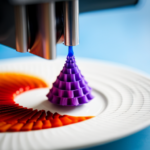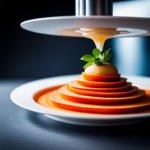Like a modern-day alchemist, the fusion of technology and cuisine has birthed a new era of culinary artistry. In this article, we explore the transformative power of 3D printed food in bridging cultures and traditions.
From ancient culinary wisdom to cutting-edge innovation, this revolutionary approach to gastronomy promises to transcend borders and bring a global feast to the table.
Join us as we delve into the intersection of culture and cuisine through the lens of 3D printed food.
The Evolution of 3D Printed Food
The evolution of 3D printed food has revolutionized the culinary industry by presenting innovative ways to create and customize edible items. 3D printing technology has allowed for the production of intricate and personalized food items that were previously unimaginable. This culinary revolution has opened up new possibilities for chefs, food designers, and consumers alike.
With 3D printing, food can be shaped and structured in ways that were once considered unattainable, showcasing the intersection of technology and gastronomy. This technology has the potential to not only revolutionize the way food is prepared and presented but also to address issues such as food sustainability and personal dietary needs. The ability to control the composition and design of food at a molecular level opens doors to a new era of culinary creativity and customization.
This innovative approach to food production is reshaping the way we think about food and culinary experiences, providing a glimpse into the future of gastronomy.
This shift towards technological advancements in food creation and design seamlessly integrates with culinary traditions and innovation, propelling the industry into a new era of creativity and possibility.
Culinary Traditions and Innovation
Discussing the evolution of 3D printed food, how does this technological advancement integrate with culinary traditions and innovation?
3D printed food represents a significant intersection between culinary creativity and technological fusion.
-
Preservation of Culinary Traditions: 3D printing allows for the recreation of traditional dishes and delicacies, preserving cultural culinary practices that might otherwise be lost over time.
-
Culinary Innovation: This technology enables chefs to experiment with new textures, shapes, and flavors, pushing the boundaries of traditional culinary experiences and opening up new possibilities for culinary expression.
-
Customization and Personalization: 3D printed food offers the potential for personalized nutrition, catering to individual dietary needs and preferences, thus revolutionizing the way food is prepared and consumed.
The integration of 3D printed food with culinary traditions and innovation demonstrates the potential for technology to enhance and transform traditional culinary practices, while also providing new avenues for creativity and expression in the culinary world. This fusion of technology and tradition not only preserves cultural heritage but also paves the way for exciting culinary innovations.
As we delve into the next section, it becomes evident that 3D printed food is more than just a technological marvel; it is a cultural fusion.
3D Printed Food: A Cultural Fusion
Integrating 3D printed food with cultural culinary practices and traditions fosters a unique fusion, showcasing the potential for technology to enrich and transform traditional gastronomic experiences.
Cultural adaptation in the realm of 3D printed food involves the incorporation of diverse ingredients, flavors, and cooking techniques from various culinary traditions around the world. This adaptation not only respects the authenticity of each culture’s cuisine but also encourages culinary creativity and innovation.
For instance, 3D printed food can be customized to suit specific cultural dietary restrictions or preferences, allowing individuals to enjoy their traditional dishes in a new and exciting way.
Moreover, the fusion of 3D printed food with cultural culinary practices opens up opportunities for cross-cultural collaborations, where chefs and food technologists can work together to create novel dining experiences that celebrate the richness of global gastronomy.
Ultimately, the integration of 3D printed food with cultural traditions serves as a bridge between the past and the future, honoring heritage while embracing technological advancements in the culinary world.
Exploring Global Flavors Through 3D Printing
As we explore the potential of 3D printed food to bridge cultures, it is important to consider the rich tapestry of global flavors that can be brought to the forefront through this innovative culinary technology.
With 3D printing, there is an opportunity to embark on a journey of culinary cross-cultural fusion, allowing for the creation of diverse gastronomic experiences that celebrate the varied tastes and traditions from around the world.
This exploration promises an innovative culinary landscape that embraces and showcases the depth and breadth of international cuisines.
Culinary Cross-Cultural Fusion
Cross-cultural culinary fusion through 3D printing is increasingly being embraced by chefs and food enthusiasts around the world. This innovative approach to food creation allows for the melding of diverse culinary traditions, resulting in a harmonious blend of flavors and textures. The combination of fusion cuisine and technological innovation has paved the way for a new era of culinary exploration, where traditional recipes are given a contemporary twist through 3D printing technology.
Some noteworthy aspects of this culinary trend include:
-
Cultural Exchange: 3D printed food enables the seamless integration of ingredients and cooking techniques from different cultures, fostering a rich exchange of culinary diversity.
-
Flavor Synthesis: The ability to precisely layer and combine ingredients allows for the synthesis of complex and unique flavor profiles.
-
Creative Expression: Chefs are able to express their creativity by reimagining traditional dishes in innovative and visually stunning ways.
This culinary revolution is not only reshaping the way we experience food but also transcending cultural boundaries, offering a tantalizing glimpse into the future of global gastronomy.
This trend seamlessly transitions into the subsequent section about ‘innovative culinary exploration’.
Innovative Culinary Exploration
The incorporation of 3D printing technology in culinary exploration allows for a precise and innovative approach to exploring global flavors and creating cross-cultural fusion dishes. By exploring technology and employing innovative design, chefs can push the boundaries of traditional culinary practices, leading to creative culinary experiences that bridge cultures.
3D printing enables the precise layering of ingredients, allowing for the creation of intricate and complex dishes that capture the essence of diverse global flavors. This innovative approach to culinary exploration opens up new possibilities for cultural fusion, as it facilitates the seamless integration of ingredients and cooking techniques from different parts of the world.
As a result, chefs can craft dishes that celebrate the diversity of global cuisines while offering a unique and harmonious blend of flavors. This exploration of global flavors through 3D printing sets the stage for diverse gastronomic experiences.
Diverse Gastronomic Experiences
Exploring global flavors through 3D printing allows for the precise layering of ingredients, enabling chefs to create diverse gastronomic experiences with seamless integration of cooking techniques from different parts of the world. This culinary innovation fosters cultural exchange and culinary diversity by bringing unique and traditional flavors to new audiences.
-
Preservation of Authentic Cuisine: 3D printing technology allows chefs to reproduce traditional dishes with utmost precision, preserving the authenticity of flavors from various regions.
-
Fusion of Culinary Techniques: Chefs can experiment with fusing cooking techniques from different cultures, leading to the creation of innovative and harmonious flavor combinations.
-
Accessible Global Cuisine: 3D printed food enables people to savor global flavors without traveling, promoting cultural appreciation and understanding through diverse culinary experiences.
Embracing Diversity in 3D Printed Cuisine
Embracing diversity in 3D printed cuisine requires a thoughtful approach to incorporating a wide range of traditional and contemporary culinary ingredients and techniques. Cultural exchange and technological advancements play a crucial role in shaping the landscape of 3D printed food. By embracing diversity, 3D printed cuisine can become a powerful tool for bringing different cultures together through the universal language of food. The fusion of traditional flavors and innovative 3D printing technology opens up a world of possibilities, allowing for the creation of unique gastronomic experiences that celebrate cultural heritage while embracing modernity.
Incorporating diverse ingredients such as spices, herbs, and unique flavor profiles from various culinary traditions enriches the 3D printing culinary landscape, offering a platform for cultural exchange and understanding. Moreover, the utilization of advanced 3D printing techniques enables chefs to experiment with intricate designs and structures, elevating the visual and sensory appeal of dishes. This harmonious blend of tradition and innovation not only expands the culinary horizons but also fosters an environment of inclusivity and appreciation for global gastronomy.
As 3D printed cuisine continues to evolve, embracing diversity will undoubtedly be instrumental in creating a more interconnected and culturally enriched culinary world.
The Future of Cross-Cultural Dining
Culinary technology is revolutionizing cross-cultural dining experiences. The future of cross-cultural dining is being shaped by cutting-edge advancements in food technology, which are fostering a new era of cultural fusion and innovation.
Key points to consider for the future of cross-cultural dining:
-
Advanced 3D Printing: Future technology will likely lead to even more advanced 3D food printers capable of producing intricate and culturally diverse dishes. This will allow for the creation of previously unimaginable cross-cultural culinary fusions, catering to a wide range of palates and preferences.
-
Virtual Reality Dining Experiences: The integration of virtual reality into dining experiences is on the horizon. This technology will enable diners to immerse themselves in culturally diverse settings, enhancing the sensory experience by simulating different cultural environments and traditions.
-
Personalized Nutritional Solutions: Future advancements in food technology will allow for personalized and culturally sensitive nutritional solutions. This will enable individuals to adhere to their cultural dietary customs while also meeting their specific nutritional needs, contributing to the preservation and celebration of diverse culinary traditions.
Frequently Asked Questions
How Does 3D Printing Technology Work in General?
3D printing technology, also known as additive manufacturing, works by creating three-dimensional objects layer by layer from a digital file. The process involves melting and fusing materials such as plastic, metal, or food ingredients.
What Are the Potential Environmental Impacts of 3D Printed Food?
The potential environmental impacts of 3D printed food are a crucial consideration for sustainability. This innovative technology has the potential to reduce food waste and energy consumption, offering a promising solution to environmental challenges in the food industry.
Are There Any Health Concerns Associated With Consuming 3D Printed Food?
Health concerns related to 3D printed food revolve around food safety, potential allergens, and the impact of printing materials on health. Cultural attitudes towards this technology may also influence perceptions of its safety and suitability for consumption.
What Are the Current Limitations of 3D Printed Food Technology?
The current limitations of 3D printed food technology encompass issues of scalability, taste quality, cost, and material availability. These challenges must be addressed to advance the technology’s potential, ensuring it meets the diverse needs of global culinary cultures.
How Do Different Cultural Attitudes Towards Food Impact the Adoption of 3D Printed Food?
Cultural acceptance significantly influences the adoption of 3D food printing. Varied culinary traditions and attitudes towards food impact the integration of this technological innovation. Understanding and respecting these cultural nuances is crucial for the successful implementation of 3D printed food.
Conclusion
In conclusion, the intersection of 3D printing and food has opened up new possibilities for bridging diverse cultural culinary traditions. This innovative technology allows for the exploration and fusion of global flavors, creating a platform for embracing diversity in cuisine.
As we look to the future of cross-cultural dining, 3D printed food has the potential to break down barriers and bring people together through the universal language of food, like a colorful tapestry woven from different threads.


